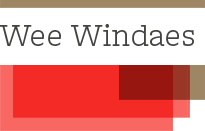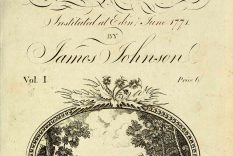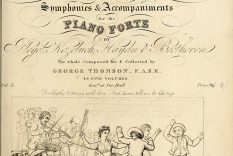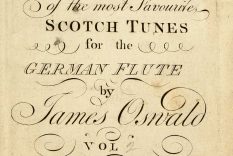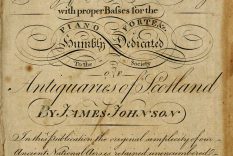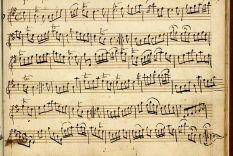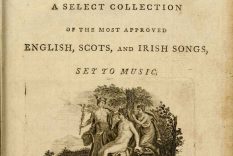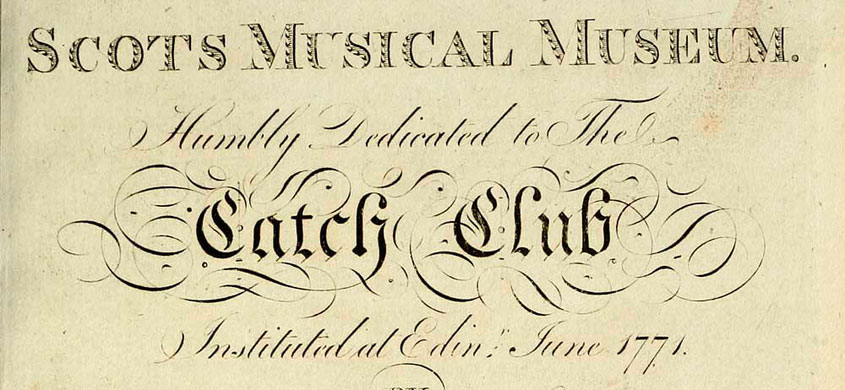
The Scots Musical Museum is mibbie the foond o Scots sang collectioun. Hit’s a sax volume wark stertit an prentit bi ae James Johnson at Bell’s Wynd, Embra. The first volume bein prentit in 1787 an the saxt ane in 1803. Hit hauds sax-hunner sangs, ae hunner sangs in ilka volume, wi the ettle fir tae be ‘a complete collection’ o ‘Scots songs’, the lik o whilk haed ne’er been seen afore.
Taewart the en o compilation o the first volume James Johnson wis introduced tae a fiddler an poet, ae Robert Burns. Burns wis settin aff on his tourie o the Borders an the Heilans an, fae haein this meetin, taen on fir tae collect tunes an sangs Scotland ower. He wid gae on fir tae contribute up tae twa hunner an fifty sangs hissel, an edit maist o the collection. Burns dee’d juist afore the fifth volume cam oot an the saxt volume, editit bi Johnson, hauds thit the collection is completit.
Atween Johnson, Burns, an music arranger Stephen Clarke, the feck o the Scots Musical Museum wis wrocht. Houane’er there weel ower a hunner men an weemen kent tae hae gied tunes an sangs fir tae get includit. Thae rax fae some o wir auldest ballads, throu folk sangs gien as they’re fun, or editit minorly or majorly bi Burns or ither collectors, throu new compositions tae auld tunes, an new compositions tae new tune.
Lear mair aboot The Scots Musical Museum
James Johnson (1750-1811) wis a Ettrick man born tae a kye hearder faither. He duin his prentice in copper engravin an went on fir tae invent a process o engravin on pewter. He cam fir tae be ane o the maist famous music engravers in Scotland, juist as the pianoforte wis takkin aff. Hit’s airgued thit onihin fae hauf, tae nearhaan aa, the music in Scotland prentit atween 1772 an 1790 wis his. In 1790 he opened a music shop on the Lawnmairket in Embra, Johnson & Co., thit bade on tae 1815 as Johnson & Anderson.
Johnson haed prentit his ‘Collection of Favourite Scots Tunes’ aroon 1770. This contains Scots named tunes sic as ‘Lassies Likes Nae Brandy’ an ‘Jocky was the Blythest Lad’, but nae sangs wi lyrics therein. By 1787 he’d ettilit at a twa volume collection o Scots, Irish an English sangs, but in Februar o that year he wis fir tae meet wi ae Robert Burns. Fae here the Scots Musical Museum wis born.
Noo Burns that year haed cam tae Embra fir tae prent the neist edition o his poetic warks aff the back o his gey successfu debut: ‘Poems, Chiefly in the Scottish Dialect’ (Kilmarnock edition). Hit maun be said, an made siccar whan talkin anent the Scots Musical Museum, thit Burns wis a fiddler, a sangster, an a poet. In the Kilmarnock edition he’d aaready publishit some o his maist weel kent sangs, sic as ‘Now Westlin Winds’, an ‘The Rigs o Barley’, wi John Barleycorn an ‘Green Grow the Rashes’ comin in the Embra edition.
Burns gied three sangs tae the first volume o the ‘Scots Musical Museum’ but went on fir tae gie as monie as twa hunner an fifty sangs, an gaither ower fower hunner o the sax hunner in the Museum.
The collectin o thir sangs wisnae as we’d mibbie think the day, wi accurate recordin o whit wis heard. Aften the sangs wis editit or wrocht new aw the gither. As Professor Fred Freeman aften quotes, Burns wrote in Dumfries April 1791 ‘I am a Fiddler and a poet’ an said ‘until I am complete master of a tune, in my own singing, (such as it is) I never can compose for it.’ Sae Burns wid edit the wirds o a sang so’s they’d fit the tune. Ither times he’d cam up wi a full new lyric tae tunes. Ae ensampul is ‘Auld Lang Syne’, fae Allan Ramsay in volume ane:
Auld Lang Syne (vol 1)
Should auld acquaintance be forgot
Tho they return with scars
These are the noble hero’s lot
Obtain’d in glorious wars
Welcome, my Varo, to my breast
Thy arms about me twine
And make me once again as blest
As I was lang syne…
Burns scrieves in his interleaved notes: ‘The Original & by much the best set of the words for this Song is as follows’ an then gies us his ain sel-written lyric tae the tune, as if they’re collectit an weel kent fae the tradition. This is later publishit in volume V, the last ane he editit.
Auld Lang Syne (vol 5)
Should auld acquaintance be forgot,
and never brought to mind?
Should auld acquaintance be forgot,
and auld lang syne?
For auld lang syne, my jo,
for auld lang syne,
we’ll tak’ a cup o’ kindness yet,
for auld lang syne…
There are ower a hunner fowk kent fir tae hae gien sangs fir the Museum includin Robert Fergusson, Thomas Blacklock, Susanna Blaimire, Agnes Maclehose, Robert Crawford, James ‘Balloon’ Tytler, and a wheen fae Allan Ramsay (taen frae his ‘Tea-table miscelleny’ Library shelfmark: ABS.1.75.179).
Ae-twa o Burns’ favourite contibutions cam fae Reverand John Skinner. Burns taen the lyric Skinner haed pitten tae the ‘Reel o Tullochgorum’, at the request o ae Mrs Montgomerie o Ellon, as ‘the best Scotch Song ever Scotland saw’. Thae lyrics is gey apt fir the hale mission o collection an celebration o Scots sang in the Museum:
Tullochgorum (vol 3)
Come, gi’e’s a sang, Montgomery cried,
And lay your disputes all aside,
What signifies’t for folks to chide
For what’s been done before them?
Let Whig and Tory all agree,
Whig and Tory, Whig and Tory,
Let Whig and Tory all agree,
To drop their Whig-mig-morum;
Let Whig and Tory all agree,
To spend the night in mirth and glee,
And cheerfu’ sing alang wi’ me
The reel of Tullochgorum…
Burns tuik aulder sangs scrievit afore his time an collectit them, sic as ‘Were na My Heart Light I Wad Die’ bi Lady Grizel Baillie (1665-1746) a acomplishit Scots sangwriter an author o ‘The Household book of Lady Grisell Baillie’ ane o wir best sources o social history throu the 17t intae 18t yearhunner.
‘The Scots Musical Museum’ wis the foond o the wark o Walter Scott’s ‘Minstrelsy of the Scottish Border’ (1802-1830) wi muckle sangs sicna ‘Patrick Spens’, James Hogg’s ‘Jacobite Relics of Scotland’ (1819-1821) an warks containin Caroline Oliphant, Lady Nairne’s sangs lik ‘The Scottish Minstrel’ (1821-24).
Burns taen nae siller fir aa the wirk he pit in tae thir volumes, yit taen hit on fir hits cultural importance, famously scrievin tae James Johnson in his last letter: ‘Your Work is a great one; and though, now that it is near finished, I see if we were to begin again, two or three things that might be mended, yet I will venture to prophesy, that to future ages your Publication will be the textbook and standard of Scottish Song and Music.’
The Scots Musical Museum is perhaps the founding text of Scots Song collection. It is a six volume work initiated, and printed, by James Johnson in his printers in Bell’s Wynd, Edinburgh. The first volume was printed in 1787 and the final volume in 1803. It contains 600 songs, 100 per volume, with the expressed aim of it being ‘a complete collection’ of ‘Scots songs’, the like of which had never been seen before.
Towards the end of completing the first volume, James Johnson was introduced to a fiddler and poet by the name of Robert Burns. Burns would soon be setting off on a tour of the Highlands and Scottish Borders, and as a consequence of this meeting, would now set out to collect songs and tunes from all over Scotland. He would go on to contribute up to 250 song himself and edit most of the collection. Sadly Burns died just before the fifth volume was published, and the sixth volume, compiled by Johnson, declares the collection complete.
The majority of the Scots Musical Museum was brought about through the work of Johnson, Burns and musical arranger Stephen Clarke. However, there are well over 100 men and women known to have contributed songs. These range from the oldest ballads, folk songs presented as found, or with minor or major edits from Burns or other collectors, through to new words set to old tunes, and new compositions set to completely new tunes.
Learn more about The Scots Musical Museum
James Johnson (1750-1811) was born in Ettrick, the son of a herdsman. He completed a printing apprenticeship as a copper engraver and went on to invent a process for engraving on pewter. He became one of the most famous music engravers in Scotland of his time, just as the pianoforte was becoming popular. It has been argued that between 1772 and 1790 anything from half to almost all of the sheet music printed in Scotland was his work. In 1790 he opened a music shop on the Lawnmarket in Edinburgh, Johnson & Co., which continued on after his death in 1811 managed by his former apprentice until 1815 and renamed as Johnson & Anderson.
Johnson had printed his ‘Collection of Favourite Scots Tunes’ around 1770. This contains tunes with Scots names such as ‘Lassies Likes Nae Brandy’ and ‘Jocky was the Blythest Lad’, but no songs with lyrics are included in it. He had intended to print a two-volume collection of Scots, Irish and English songs by 1787 but in February of that year he met Robert Burns and the Scots Musical Museum was born.
Burns had come to Edinburgh the same year to produce the next edition of his poetic works following his very successful debut ‘Poems, Chiefly in the Scottish Dialect’ published in Kilmarnock. It should be highlighted, particularly when speaking of the Scots Musical Museum, that Robert Burns was a fiddler, a songwriter, and a poet. In the Kilmarnock edition he had already published some of his more famous songs, such as ‘Now Westlin Winds’, and ‘The Rigs o Barley’, with ‘John Barleycorn’ and ‘Green Grow the Rashes’ to be published in the Edinburgh edition later that year.
Burns contributed three songs to the first volume of the ‘Scots Musical Museum’ but went on to contribute as many as 250, and collect over 400 of the 600 songs in the Museum.
This song collection was perhaps not what we would expect today with accurate recording of what was heard. Instead, the songs were often heavily edited or completely rewritten. Professor Fred Freeman often quotes what Burns wrote in Dumfries April 1791: ‘I am a Fiddler and a poet’ and ‘until I am complete master of a tune, in my own singing, (such as it is) I never can compose for it’. Burns would therefore edit the words of a song so that they would better fit the tune. In other cases he would write full new lyrics to tunes. One example is ‘Auld Lang Syne’, from Allan Ramsay in volume one:
Auld Lang Syne
Should auld acquaintance be forgot
Tho they return with scars
These are the noble hero’s lot
Obtain’d in glorious wars
Welcome, my Varo, to my breast
Thy arms about me twine
And make me once again as blest
As I was lang syne
Burns writes in his interleaved notes: ‘The original & by much the best set of the words for this Song is as follows’ and he then provides his own self-written lyric to the tune, as if it has historical precedence and taken from tradition. This is later published in volume V, the last one he edited.
Auld Lang Syne
Should auld acquaintance be forgot,
and never brought to mind?
Should auld acquaintance be forgot,
and auld lang syne?
For auld lang syne, my jo,
for auld lang syne,
we’ll tak’ a cup o’ kindness yet,
for auld lang syne…
Over 100 other people are known to have contributed to the ‘Scots Musical Museum’ including the poets Robert Fergusson, Thomas Blacklock and Susanna Blaimire as well as Burns’ paramour Agnes Maclehose, Robert Crawford, James ‘Balloon’ Tytler, and a significant number from Allan Ramsay himself (taken from his ‘Tea-table miscelleny’ lyrics and set to the recommended tunes.
One or two of Burns’ favourite contributions came from Reverend John Skinner. Burns considered the lyric Skinner had put to the ‘Reel o Tullochgorum’, at the request of Mrs Montgomerie of Ellon, as ‘the best Scotch Song ever Scotland saw’. Those lyrics are very apt for the overall mission of the collection and celebration of Scots song in the Museum:
Tullochgorum (vol 3)
Come, gi’e’s a sang, Montgomery cried,
And lay your disputes all aside,
What signifies’t for folks to chide
For what’s been done before them?
Let Whig and Tory all agree,
Whig and Tory, Whig and Tory,
Let Whig and Tory all agree,
To drop their Whig-mig-morum;
Let Whig and Tory all agree,
To spend the night in mirth and glee,
And cheerfu’ sing alang wi’ me
The reel of Tullochgorum…
Burns also took songs written before his time and collected them, such as ‘Were na My Heart Light I Wad Die’ by Lady Grizel Baillie (1665-1746) an accomplished Scots songwriter and author of ‘The Household book of Lady Grisell Baillie’ one of our best primary documents for domestic social history through the 17th into the 18th century.
The ‘Scots Musical Museum’ was the foundation of works such as Walter Scott’s ‘Minstrelsy of the Scottish Border’ (1802-1830) which has the big ballads, such as ‘Patrick Spens’, James Hogg’s ‘Jacobite Reliques’ (1819-1821) and works containing Caroline Oliphant, Lady Nairne’s songs like’ The Scottish Minstrel’ (1821-24).
Burns refused payment for the work he did in compiling and editing these volumes. He did it for its cultural importance, famously writing to James Johnson in his last letter:
‘Your Work is a great one; and though, now that it is near finished, I see if we were to begin again, two or three things that might be mended, yet I will venture to prophesy, that to future ages your Publication will be the textbook and standard of Scottish Song and Music.’
- Author:
- James Johnson
- Publication Date:
- 1787
- Imprentit:
Edinburgh
Auld Lang Syne
Should auld acquaintance be forgot,
and never brought to mind?
Should auld acquaintance be forgot,
and auld lang syne?For auld lang syne, my jo,
for auld lang syne,
we’ll tak’ a cup o’ kindness yet,
for auld lang syne
